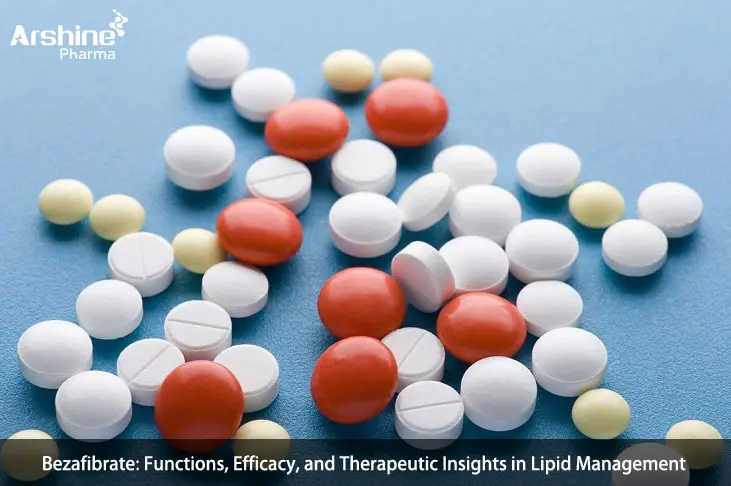
Introduction:
Bezafibrate, a fibrate medication, stands as a crucial component in the management of lipid disorders, particularly in modulating lipid levels and reducing cardiovascular risk. Renowned for its efficacy in improving lipid profiles by lowering triglycerides and increasing high-density lipoprotein cholesterol (HDL-C), bezafibrate plays a pivotal role in lipid management. This comprehensive exploration aims to unravel the mechanisms of action, functions, therapeutic uses, and efficacy of bezafibrate in promoting cardiovascular health and managing lipid abnormalities.
Understanding Bezafibrate:
Bezafibrate belongs to the class of fibrates, specifically fibric acid derivatives, used predominantly to lower elevated triglyceride levels and modify lipid profiles. Chemically, it is known as 2-(4-{2-[(4-chlorobenzoyl)amino]ethyl}phenoxy)-2-methylpropanoic acid. This compound exerts its pharmacological effects by activating peroxisome proliferator-activated receptor alpha (PPARα), a nuclear receptor involved in lipid metabolism regulation.
Functions and Mechanisms of Action:
1. PPARα Activation: Bezafibrate acts as a PPARα agonist, binding to PPARα receptors in the nucleus of cells, leading to the upregulation of genes involved in lipid metabolism. This activation enhances the breakdown of triglycerides, increases HDL-C levels, and promotes fatty acid oxidation.
2. Lipid Modulation: Bezafibrate primarily targets elevated triglyceride levels, lowering them by decreasing the production of very-low-density lipoprotein (VLDL) and enhancing the clearance of triglyceride-rich lipoproteins from the blood.
3. HDL-C Elevation: It increases HDL-C levels by stimulating the production of apolipoprotein A-I and A-II, essential components of HDL particles responsible for reverse cholesterol transport from peripheral tissues to the liver for excretion.
4. Anti-inflammatory Effects: Bezafibrate exhibits anti-inflammatory properties by reducing markers of inflammation and oxidative stress, potentially contributing to its cardiovascular protective effects beyond lipid modification.
Efficacy in Lipid Management:
1. Hypertriglyceridemia: Bezafibrate is highly effective in managing elevated triglyceride levels, particularly in individuals with severe hypertriglyceridemia, reducing the risk of pancreatitis and cardiovascular events associated with high triglycerides.
2. Low HDL-C Levels: It is beneficial in increasing HDL-C levels, especially in patients with low HDL-C, a significant risk factor for cardiovascular disease.
3. Dyslipidemia: Bezafibrate is utilized in the management of mixed dyslipidemia (elevated triglycerides and low HDL-C) and in combination with other lipid-lowering agents for comprehensive lipid control.
4. Atherosclerosis Prevention: By modifying lipid profiles, particularly by lowering triglycerides and increasing HDL-C, bezafibrate contributes to reducing atherosclerosis progression and cardiovascular risk.
5. Metabolic Syndrome: It may have a role in managing metabolic syndrome by addressing dyslipidemia, insulin resistance, and inflammation components associated with the syndrome.
Therapeutic Considerations and Insights:
1. Dosage and Administration: Bezafibrate is available in various formulations, including tablets and capsules, with dosages determined based on individual patient lipid profiles and response to treatment.
2. Combination Therapy: It is sometimes used in combination with other lipid-lowering medications, such as statins or ezetimibe, to achieve optimal lipid control, especially in individuals with complex lipid disorders.
3. Side Effects and Precautions: Common side effects may include gastrointestinal disturbances, myopathy, and abnormal liver function tests. Precautions should be taken in patients with renal impairment or hepatic disorders.
4. Monitoring and Follow-Up: Regular monitoring of lipid profiles, liver function tests, and muscular symptoms is recommended during treatment with bezafibrate to ensure efficacy and safety.
5. Individualized Treatment: Treatment with bezafibrate should be individualized, considering the patient's lipid profile, cardiovascular risk factors, comorbidities, and potential drug interactions.
Conclusion:
Bezafibrate, as a PPARα agonist and lipid-modifying agent, plays a significant role in managing dyslipidemia, particularly in reducing triglycerides and increasing HDL-C levels. Its mechanisms of action, including PPARα activation and lipid metabolism modulation, contribute to its efficacy in improving lipid profiles and reducing cardiovascular risk. However, careful consideration of dosage, monitoring for side effects, and individualized treatment approaches are crucial to ensure its safe and effective use in lipid management. As ongoing research continues to explore its mechanisms and potential applications, bezafibrate remains a valuable therapeutic option in promoting cardiovascular health and managing lipid abnormalities.
